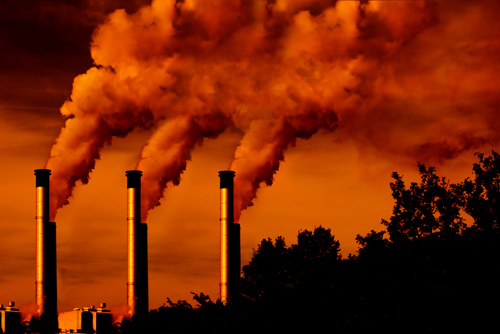



Manik Roy and Janet Peace are intimately familiar with the climate change legislation currently being considered by the U.S. Congress. Dr. Roy is the VP of Federal Government Outreach for the Pew Center on Global Climate Change, and he has more than 25 years of experience in the area of environmental policy. He previously worked for Rep. Henry Waxman (D-CA), who is the co-sponsor of the climate change legislation recently passed by the U.S. House of Representatives. In addition to his legislative experience, Dr. Roy also worked for a plating shop, where he was responsible for assisting the company in compliance with toxic chemical right-to-know laws for both the state of Massachusetts and OSHA.
Dr. Janet Peace is an economist by trade and currently serves as Pew’s VP of Markets and Business Strategy. Dr. Peace has spent her time contemplating policy options for businesses as they relate to environmental policy. She believes that industry must be part of the solution and is also involved with the United States Climate Action Partnership (USCAP), which aims to develop sensible and effective U.S. climate policy.
Another detail that is also quite apparent from the conversation: Cap-and-trade approaches, initiated by Congressional action, will provide manufacturers and emitters with far more flexibility when it comes to curbing greenhouse gas emissions. This is in contrast to the EPA’s “command-and-control” approach, which would be implemented in the absence of a comprehensive nationwide policy passed by Congress.
MF: Dr. Roy, at this past April’s NASF Washington Forum, you said that climate change legislation in the U.S. “is a matter of when, not if.” Do you still feel this is true?
Roy: Yes I do, and let me give you three directions that greenhouse gas regulation will come from if we don’t get a law through. A couple years ago the Supreme Court directed the EPA to head down a path that will result in command-and-control regulation of greenhouse gas emissions, unless Congress steps in and does it legislatively. The EPA, in absence of Congressional action, is in fact taking those steps. So that’s one direction. If we don’t act legislatively, we’re going to have command-and-control regulation from the EPA as required by the Supreme Court.
Second direction: We’re starting to see nuisance lawsuits bubbling through the process in which plaintiffs are pointing to various large emitters of greenhouse gasses and saying, “You are contributing in a significant way to climate change. Climate change is having an impact on my interests and, therefore, I’m going to go after you under the nuisance law rubric.”
Third: We have 23 states across the country that are in the process of implementing greenhouse gas cap and trade. So there is not a “no-regulate” option. Either way we are going to be regulating greenhouse gasses. There are probably 100 dumb ways of doing it—there are a couple of smart ways. The cap-and-trade approach that the Congress is currently considering is preferable to a command-and-control approach, it’s preferable to nuisance lawsuits, and it’s preferable to the states’ patchwork efforts.
MF: A cap-and-trade system would absolve these affected businesses from potential nuisance lawsuits, correct?
Roy: Cap and trade, because it provides a solution to the complaint. Now I’m not a lawyer, but it is my understanding that it could be used as a defense against a nuisance lawsuit.
MF: During this same Washington Forum, you noted that the EPA’s new greenhouse gas reporting requirements would not likely affect small businesses, such as most surface finishers. Do you still feel that this is a valid assumption?
Roy: As I understand the regulation, and as I understand the [surface finishing] industry, that is still true. Only fairly large, direct emitters of greenhouse gasses would be required to report under that rule.
MF: Who is more likely to move first on regulating greenhouse gasses in the United States and coming up with a policy: the Congress or the EPA?
Roy: Congress has actually been debating this issue in earnest since 2003. EPA, as required by Congress, is in the process of requiring all large emitters of greenhouse gasses to report their emissions. They’ll be reporting it for the calendar year 2010 and will be reporting that information in 2011. So EPA is already starting to go down that path. But the major command-and-control regulation of some large stationary sources is probably a few years away. If Congress does not step in, it would probably be a few years before the EPA’s command-and-control regulation was put in place.
MF: Many business owners hear the words “cap-and-trade,” but they don’t really understand what it entails. Briefly describe how the system would work, and what it is intended to accomplish?
Roy: It applies directly to large emitters, oil refiners and importers, and large distributors of natural gas. As currently debated by Congress, the greenhouse gas cap-and-trade rule would probably not apply to most metal finishers.
Under the system, the United States would set an annual limit on the total emissions of greenhouse gasses that these various large sources could put into the atmosphere. If you are one of these sources, you have to submit an allowance for every ton of greenhouse gasses that you put into the atmosphere. These allowances can be bought and sold between those large emitters, and what happens is that if there is a company out there that can very inexpensively reduce its emissions by either improving efficiency or by installing some new equipment, and it can do it less expensively than another company, then it will do just that, and it will have leftover allowances to sell. In effect, you are creating an incentive for industry to innovate in efficiency and develop low-carbon ways to use energy.
Peace: Cap and trade really gives the most flexibility to allow companies to figure out the best ways to get those initial reductions. In the command-and-control approach, government says, “This is how you will do it.” Under the cap-and-and trade approach, firms have the ability to innovate. They have an incentive to innovate because the more they innovate, the more they reduce, the better off they are. And the gains from trading really come about because different facilities have different costs with respect to reductions, so trading allows flexibility in achieving these goals.
MF: So cap and trade ensures the cheapest, most effective process for facilities to control their emissions?
Roy: Under cap and trade, no EPA regulator could go up to a factory and say: “Here is your emission limit.” In fact, if a facility wanted to double its emissions, it could. It would just have to buy more allowances and use that as another input factor. Under cap and trade, no EPA person would come into a factory and say, “You need to use [this] technology.” You can use any technology you want, just as long as the emissions you produce are covered by allowances. Again, this would not apply to most metal finishers unless they are captive in some huge operation.
Peace: There is a threshold. In the bills that are being debated today, you have to emit 25,000 tons [per year]. And if you don’t meet that threshold, then you are not required to hold these allowances. So by giving firms the flexibility to choose their methods of reduction, we will be able to achieve these limits much more cheaply.
MF: For whom and by how much would energy costs increase under a cap-and-trade system? Estimates being thrown about vary greatly, from $3,000 per family per year, according to a GOP estimate based on an MIT study—with disputed interpretations—to as little as $175 per family per year, according to a Congressional Budget Office estimate. Why is there such uncertainty among these estimates?
Peace: The important thing to remember is that the modeling that these numbers are coming out of is best suited for looking at insights. The models are really not well designed to tell us what it is going to cost in 2050. Every model depends on the assumptions that you throw into it, and the models that typically have the highest costs are the ones that assume that we [as a country] are not very innovative. They assume that we will not have new technology available by 2030 or 2050, and that if we do have this new technology that it’s going to be super expensive.
The models are guess models. They are abstract reality. They are there to give us insights, but they are not very good at giving us output predictions, and they really depend on what our view of the future looks like. I personally think that we are pretty innovative. I’m very optimistic that we will be able to figure out how to make things like solar energy more cheaply, but it really depends on what your view of the future looks like.
Roy: The modeling here does not account for the benefits of avoiding uncontrolled climate change. The science is telling us, with a pretty high level of confidence, that we should expect to see sea levels rise, more extreme weather, more floods, more droughts. In the West, where I’m from originally, [it means] less snowpack, which will make the managing of water resources more expensive. So uncontrolled climate change has economic costs.
Another factor not figured in here is clean energy technology. Clean energy technology is going to be one of the major growth industries of the 21st century. There are other countries around the world, including China, that are making major investments in being the global leaders in this area. Cap and trade is probably one of the most effective ways that we can ease ourselves into a leadership position in [this] market as well.
Peace: Companies that are focusing on low-carbon innovation are increasingly being rewarded in the marketplace. Companies are increasingly seeing a profit incentive from moving into this [clean energy] area.
MF: Would costs vary state to state, or by region? Which regions would face the most severe increases? Won’t a cap-and-trade system create a disproportionate burden on industries in states where coal is used to generate electricity, such as Michigan, Ohio, Indiana, and the like?
Peace: It’s important to note that policy makers are thinking about these regional impacts. It’s not being ignored by legislators, and it’s certainly not being ignored in the bill [being considered by Congress]. The higher costs in a particular region [are] being dealt with, in large part, through allocations. Giving allowances freely for the purposes of protecting consumers, businesses, or households is a real important part of the package that USCAP is advocating for, but it’s also a large part of the package that the House voted on, and what the U.S. Senate is considering as well.
Roy: The answer depends entirely on the design of the bill. It’s not the fact that cap and trade affects one region more than the other, it’s how you design the cap and trade. How Congress decides the allowances are given out makes all the difference. [For example], If Congress says that coal-dependent regions in this country are going to pay a disproportionate amount early on, then we want to create a better transition. Congress has the ability to do this under a cap and trade in a way that they really cannot under a [carbon] tax scheme, under a command-and-control system, certainly under a nuisance law situation. Cap and trade actually gives you the flexibility to deal with that regional disparity.
MF: Under the Waxman-Markey bill, which industries would receive free permits? If energy companies are slated to receive free permits under the bill, then why would energy costs potentially increase for end users? And where will the money go for carbon permits that are sold by the government?
Roy: A large fraction of the allowance value would be given to the regulated electric utilities.
Peace: The local distribution companies, which are regulated by the public utility commissions, whose sole job is to protect the consumers, so you give the allowances to the LDC, and the LDC sell back to the generators. And generators see a price, and consumers are shielded because of the way the LDC is regulated.
Roy: A lot of other allowance values would be given out to manufacturers that sell in the international marketplace and are fairly energy-intensive in their manufacturing process. Specifically, this would address competitive imbalance. These manufacturers are competing with companies in countries that have not yet moved to address their greenhouse gas emissions with regulations, and this allowance value would go to them to make sure there is no incentive for these companies to ship those jobs and the pollution out of the country. Almost 85% of the allowance value under the Waxman-Markey bill is given out for free. In this respect, the bill is different from a tax because taxes take all the money and they bring them into government. Five percent of allowances under this bill would go right back out.
Peace: They [permit fees] don’t necessarily go back to the emitters. They go back to states for low-income households who might see an impact through higher electricity bills. There are lots of pieces of this bill that are designed to protect consumers from higher prices.
MF: So the permit fees are intended to help subsidize the potential impacts on consumers under a cap-and-trade system?
Peace: I wouldn’t say “subsidize.” I would say “shield.”
MF: Will cap and trade damage U.S. manufacturing and business competitiveness while ultimately costing more domestic manufacturing jobs? Is this a potentially disastrous policy to consider as the U.S. economy begins to emerge from a deep recession, especially in light of the fact that the economy is still shedding jobs?
Roy: This system would not go in place for a few years. The rules that we are talking about now would not go into effect until 2012, and they may be pushed back further. So this would not be in what I think anyone would believe to be a recession economy. Through the allowance allocation to the manufacturers, we will be preventing the competitive imbalance that may otherwise face manufacturers. Clean energy technology, efficiency—all those technologies will be a major growth industry of the 21st century. The United States is in a race, whether we like it or not. We can either do something to help us win that race, or we can sit back and let other countries do it.
Peace: It’s an important investment in that future we are talking about here.
MF: What is the potential upside for members of the business and manufacturing communities who may be skeptical of a cap-and-trade system?
Roy: If you are any kind of innovator, there is an upside. If you are an innovator in clean energy in particular, whether you are making materials that use energy more efficiently, or allow your customers to use it more efficiently. If you’re a plater, there are various applications that are getting more demand because of clean energy. And those are the folks who are going to see the benefits.
MF: In terms of business opportunities, who stands to benefit from potential greenhouse gas and cap-and-trade legislation?
Roy: Anybody who has ideas for improving the efficient use of electricity. Anybody who can contribute to the clean energy economy and race—those industries will benefit.
Peace: There is a huge push on the clean energy effort right now. It’s across countries, states, and companies. It’s around the world. We want to be at the front of that race. Companies that get out and lead will definitely have a competitive edge. For one, they will become more efficient. They will also be in front of the innovation curve, which is an important place to be in. We have done this before; we just need to do it again.
Roy: And we need to do it as a country.
MF: What resources are available for businesses, especially small businesses, so that they can prepare for and inform themselves about the potential impacts of a cap-and-trade system?
Peace: On our website (see the "Downloads" sidebar) we have a partnership grid that gives information on resources for small and large businesses. The EPA SmartWay partnership is another good guide. It has technical data, information, and webinars for companies big and small. Climate Leaders is another good resource for businesses. EPA works with companies to develop strategies. There is even the Small Business Network that they plan on implementing in January of 2010. So there are quite a lot of resources. But I would start with the partnership grid on our website as a source of information for businesses both large and small.
MF: Finally, I understand that 1 ton of carbon emitted in Cleveland contributes to global warming just as much as 1 ton released in Guangzhou. Why is it important that the U.S. take the global lead on curbing greenhouse gas emissions, especially if other major emitters do not promise to reduce their own?
Roy: We need an international treaty that gets a commitment from all the major economies, not just the developed countries. So we absolutely agree with that. But how do we get that treaty? The United States is the most powerful, most innovative country in the history of the world. If we do not lead on this issue, how can we expect countries that use a fraction of per capita energy that we use to follow?
As we take legislative action, we need to make sure that we have the other major emitters joining us. It’s remarkable that a lot of the developing countries (like China, India, and Brazil) are starting to signal a willingness to do far more on this issue then they ever have before. I think part of that is because they recognize the impact climate change will have on them, and they realize that clean energy is a huge international market, and they want to be at the front end of that race.
MF: What are the odds that we have a comprehensive national policy before the climate talks in Copenhagen this December?
Roy: I don’t think it’s a very high chance. I think there’s a shot. Our goal in Copenhagen will be to narrow the scope of negotiations, continue the work on domestic policy in the United States, and once we get that wrapped up, go to the international community and say , “OK, were taking our step, now it’s time for all of us to move together on this.”
MF: Do U.S. companies (and their products) face a potential backlash from global consumers if the nation fails to enact legislation that reduces greenhouse gas emissions? Will failure to act damage our standing in the global marketplace?
Roy: If we fail to enact legislation, we are still going to have command-and-control regulation, we are still going to have nuisance lawsuits, we are still going to have regulation by several states.
Peace: It’s not that we are going to fail to [have] a climate policy, we are just talking about who is going to do it and when.
Roy: The question is whether we will get a rational climate policy. Many heads of state have been meeting with President Obama. My understanding is that many of them have been telling him that if the United States does not take a leadership role on this issue, then it will hurt America’s. standing internationally. I think one of the things we have learned is how interconnected we are. We really do have an interest in continuing our historic leadership role. If we don’t act accordingly, it will hurt our ability to maintain that international leadership.

